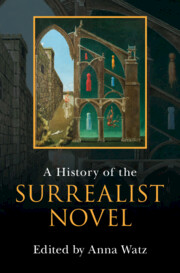Book contents
- A History of the Surrealist Novel
- A History of the Surrealist Novel
- Copyright page
- Dedication
- Contents
- Figures
- Contributors
- Acknowledgements
- Introduction
- I Marvellous Beginnings
- II Transgression and Excess
- Chapter 7 The Surrealist Novel and the Gothic
- Chapter 8 Surrealism’s Anti-Bildungsroman
- Chapter 9 The Mother Figure in the Surrealist Novel
- Chapter 10 British Surrealism at War
- Chapter 11 Surrealist Narratives of Trauma
- III Science, Alchemy, Nature
- IV Transnational Surrealism
- Index
Chapter 9 - The Mother Figure in the Surrealist Novel
from II - Transgression and Excess
Published online by Cambridge University Press: 02 February 2023
- A History of the Surrealist Novel
- A History of the Surrealist Novel
- Copyright page
- Dedication
- Contents
- Figures
- Contributors
- Acknowledgements
- Introduction
- I Marvellous Beginnings
- II Transgression and Excess
- Chapter 7 The Surrealist Novel and the Gothic
- Chapter 8 Surrealism’s Anti-Bildungsroman
- Chapter 9 The Mother Figure in the Surrealist Novel
- Chapter 10 British Surrealism at War
- Chapter 11 Surrealist Narratives of Trauma
- III Science, Alchemy, Nature
- IV Transnational Surrealism
- Index
Summary
In the surrealist revolt against the state, the Church, and the family, the mother figure became a key target, both as custodian of bourgeois-patriarchal values and as symbol of Catholic doctrine. In works such as Georges Bataille’s Story of the Eye (1928), Salvador Dalí and Luis Buñuel’s L’age d’or (1930), and Joyce Mansour’s Jules César (1955), mothers are attacked and violated, suffering a fate similar to those of the detested mother figures in the fiction of the Marquis de Sade. Yet not all mothers in surrealist art and literature are portrayed in such unequivocally negative terms. Focusing on Leonor Fini’s Mourmour, conte pour enfants velus (1976) and Dorothea Tanning’s Chasm: A Weekend (2004), this chapter traces an alternative history of surrealist representations of the mother, one in which this figure is rendered more ambiguous and at times even invested with revolutionary potential. These novels, the chapter suggests, elaborate representations of maternity in critical dialogue with Freudian and Lacanian psychoanalysis. As such they resonate to some extent with the (largely contemporaneous) work of French feminist theorists such as Julia Kristeva, Luce Irigaray, and Hélène Cixous, in which the concept of maternity becomes configured as an alternative to the phallocentric symbolic order.
Keywords
- Type
- Chapter
- Information
- A History of the Surrealist Novel , pp. 152 - 167Publisher: Cambridge University PressPrint publication year: 2023



